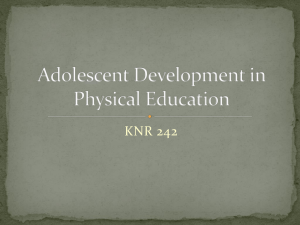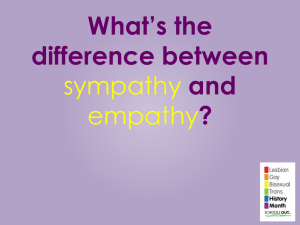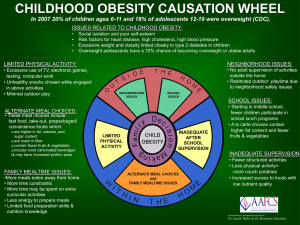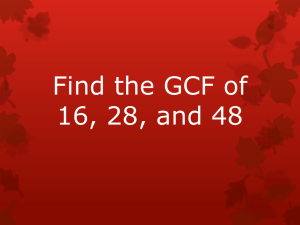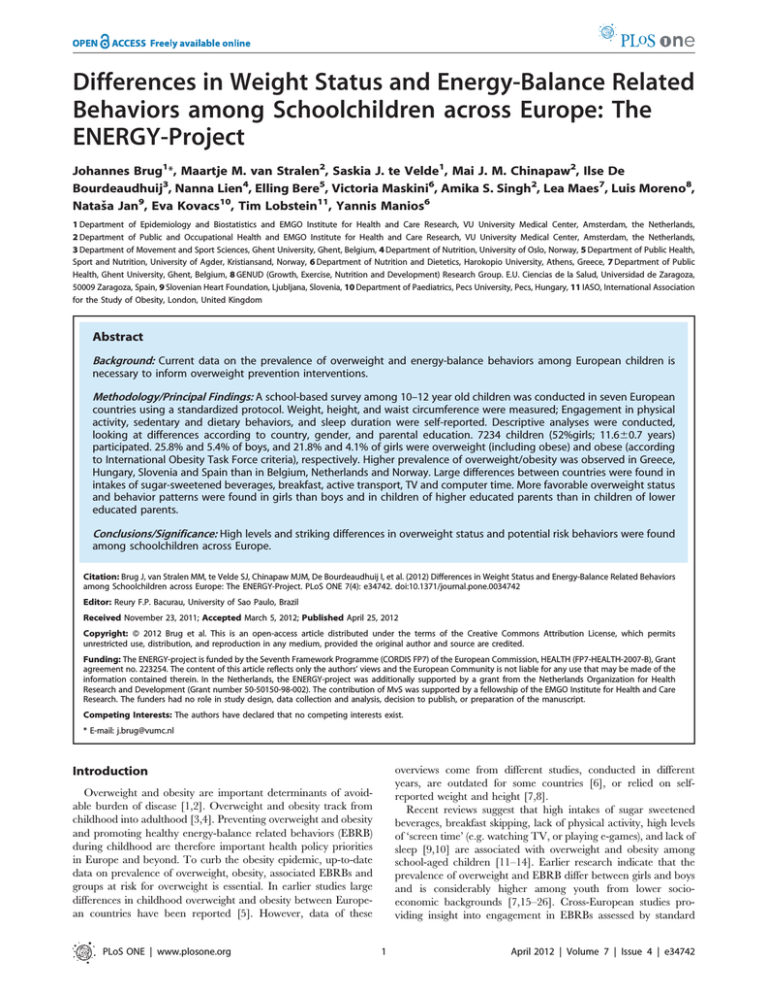
Differences in Weight Status and Energy-Balance Related
Behaviors among Schoolchildren across Europe: The
ENERGY-Project
Johannes Brug1*, Maartje M. van Stralen2, Saskia J. te Velde1, Mai J. M. Chinapaw2, Ilse De
Bourdeaudhuij3, Nanna Lien4, Elling Bere5, Victoria Maskini6, Amika S. Singh2, Lea Maes7, Luis Moreno8,
Natasˇa Jan9, Eva Kovacs10, Tim Lobstein11, Yannis Manios6
1 Department of Epidemiology and Biostatistics and EMGO Institute for Health and Care Research, VU University Medical Center, Amsterdam, the Netherlands,
2 Department of Public and Occupational Health and EMGO Institute for Health and Care Research, VU University Medical Center, Amsterdam, the Netherlands,
3 Department of Movement and Sport Sciences, Ghent University, Ghent, Belgium, 4 Department of Nutrition, University of Oslo, Norway, 5 Department of Public Health,
Sport and Nutrition, University of Agder, Kristiansand, Norway, 6 Department of Nutrition and Dietetics, Harokopio University, Athens, Greece, 7 Department of Public
Health, Ghent University, Ghent, Belgium, 8 GENUD (Growth, Exercise, Nutrition and Development) Research Group. E.U. Ciencias de la Salud, Universidad de Zaragoza,
50009 Zaragoza, Spain, 9 Slovenian Heart Foundation, Ljubljana, Slovenia, 10 Department of Paediatrics, Pecs University, Pecs, Hungary, 11 IASO, International Association
for the Study of Obesity, London, United Kingdom
Abstract
Background: Current data on the prevalence of overweight and energy-balance behaviors among European children is
necessary to inform overweight prevention interventions.
Methodology/Principal Findings: A school-based survey among 10–12 year old children was conducted in seven European
countries using a standardized protocol. Weight, height, and waist circumference were measured; Engagement in physical
activity, sedentary and dietary behaviors, and sleep duration were self-reported. Descriptive analyses were conducted,
looking at differences according to country, gender, and parental education. 7234 children (52%girls; 11.660.7 years)
participated. 25.8% and 5.4% of boys, and 21.8% and 4.1% of girls were overweight (including obese) and obese (according
to International Obesity Task Force criteria), respectively. Higher prevalence of overweight/obesity was observed in Greece,
Hungary, Slovenia and Spain than in Belgium, Netherlands and Norway. Large differences between countries were found in
intakes of sugar-sweetened beverages, breakfast, active transport, TV and computer time. More favorable overweight status
and behavior patterns were found in girls than boys and in children of higher educated parents than in children of lower
educated parents.
Conclusions/Significance: High levels and striking differences in overweight status and potential risk behaviors were found
among schoolchildren across Europe.
Citation: Brug J, van Stralen MM, te Velde SJ, Chinapaw MJM, De Bourdeaudhuij I, et al. (2012) Differences in Weight Status and Energy-Balance Related Behaviors
among Schoolchildren across Europe: The ENERGY-Project. PLoS ONE 7(4): e34742. doi:10.1371/journal.pone.0034742
Editor: Reury F.P. Bacurau, University of Sao Paulo, Brazil
Received November 23, 2011; Accepted March 5, 2012; Published April 25, 2012
Copyright: ß 2012 Brug et al. This is an open-access article distributed under the terms of the Creative Commons Attribution License, which permits
unrestricted use, distribution, and reproduction in any medium, provided the original author and source are credited.
Funding: The ENERGY-project is funded by the Seventh Framework Programme (CORDIS FP7) of the European Commission, HEALTH (FP7-HEALTH-2007-B), Grant
agreement no. 223254. The content of this article reflects only the authors’ views and the European Community is not liable for any use that may be made of the
information contained therein. In the Netherlands, the ENERGY-project was additionally supported by a grant from the Netherlands Organization for Health
Research and Development (Grant number 50-50150-98-002). The contribution of MvS was supported by a fellowship of the EMGO Institute for Health and Care
Research. The funders had no role in study design, data collection and analysis, decision to publish, or preparation of the manuscript.
Competing Interests: The authors have declared that no competing interests exist.
* E-mail: j.brug@vumc.nl
overviews come from different studies, conducted in different
years, are outdated for some countries [6], or relied on selfreported weight and height [7,8].
Recent reviews suggest that high intakes of sugar sweetened
beverages, breakfast skipping, lack of physical activity, high levels
of ‘screen time’ (e.g. watching TV, or playing e-games), and lack of
sleep [9,10] are associated with overweight and obesity among
school-aged children [11–14]. Earlier research indicate that the
prevalence of overweight and EBRB differ between girls and boys
and is considerably higher among youth from lower socioeconomic backgrounds [7,15–26]. Cross-European studies providing insight into engagement in EBRBs assessed by standard
Introduction
Overweight and obesity are important determinants of avoidable burden of disease [1,2]. Overweight and obesity track from
childhood into adulthood [3,4]. Preventing overweight and obesity
and promoting healthy energy-balance related behaviors (EBRB)
during childhood are therefore important health policy priorities
in Europe and beyond. To curb the obesity epidemic, up-to-date
data on prevalence of overweight, obesity, associated EBRBs and
groups at risk for overweight is essential. In earlier studies large
differences in childhood overweight and obesity between European countries have been reported [5]. However, data of these
PLoS ONE | www.plosone.org
1
April 2012 | Volume 7 | Issue 4 | e34742
Weight Status in European Schoolchildren
methodology, and their socio-demographic correlates are lacking.
The present study presents data from the ‘‘EuropeaN Energy
balance Research to prevent excessive weight Gain among Youth’’
(ENERGY)-project on measured weight status and reported
EBRB among 10–12 year olds in and differences between seven
European countries [27]. The specific research questions are:
I.
II.
III.
randomly selected from each of the lowest, mid and highest
tertiles of degree of urbanisation (i.e. the percentage of inhabitants
living in towns of .20,000 persons). A municipality of .20,000
inhabitants from each selected province was randomly chosen,
with schools randomly selected for inclusion in the study from all
schools in that municipality. The clustering of the survey was taken
into account in sample size calculations.
A school recruitment letter was sent to the headmaster or
principal of the sampled schools, followed by a personal telephone
call. Following the school’s agreement, parents received a letter
explaining the study purpose and were asked for written consent
for their child’s and own participation.
What are the distributions and differences in body mass
index (BMI), waist circumference (WC), overweight and
obesity in schoolchildren in seven countries across Europe?
What are the distribution and differences in dietary, physical
and sedentary activities and sleeping duration in these
countries across Europe?
What are differences in anthropometrics and EBRB
according to sex and parental education across different
countries in Europe?
Measures
Measurements were conducted according to standardized
protocols. Dietary, physical activity and screen viewing behaviors
were assessed by the child questionnaire. Child’s sleep duration
was reported by the parent. The children completed questionnaires and anthropometric measurements during school time.
Test-retest reliability was tested by administrating the questionnaire twice with a one week interval among 720 schoolchildren
across the participating countries. The intraclass coefficients and
percentage agreement was good to excellent for 77% of items and
construct validity was moderate to excellent for 73% of the items
[30]. In the paragraphs hereafter information on the Intraclass
coefficients (ICC) is provided for the specific questionnaire items.
Detailed information regarding the procedures, training of
research staff, development of the questionnaire [28], and testretest reliability and construct validity [30] is published elsewhere.
Weight, Height and waist-circumference (WC). Body
height, weight, and WC were measured by trained research
assistants. The children were measured in light clothing without
shoes. Body height was measured with Seca Leicester Portable
stadiometer (accuracy of 0.1 cm). Weight was measured with a
calibrated electronic scale SECA 861 (accuracy of 0.1 kg), WC
with the SECA 201 measuring band (accuracy 0.1 cm). Two
readings of each measurement were obtained. If the two readings
differed more than 1%, a third measurement was taken. Body
mass index (BMI) and overweight status (overweight, obesity)
based on the International Obesity Task Force criteria (IOTF)
[31] as well as the WHO criteria [32] were calculated to enable
comparison with other studies that applied either of these criteria.
Dietary behaviors. Intakes of soft drinks and fruit juices
were each assessed with two food frequency questions (FFQ). First
children were asked on how many days per week they drank the
beverage on a seven point scale ranging from never to more than
once every day (ICC soft drink = 0.72; ICC fruit juice = 0.64).
Subsequently they were asked to indicate how much they drank on
days they consumed the beverage by ticking the number of glasses
(or small bottles, i.e. 250 ml; ICC = 0.59), cans (i.e. 330 ml;
ICC = 0.53)) and/or large bottles (i.e. 500 ml; ICC = 0.59) for soft
drinks, or glasses/small cartons (250 ml; ICC = 0.54) and/or
regular cartons (330 ml; ICC = 0.52) for fruit juices. Pictures of the
serving sizes were printed in the questionnaire. Mean intake in ml
per day was calculated from the FFQ by multiplication of number
of days per week and amount per day in ml divided by 7.
Additionally, children were asked to indicate how much of the
beverages they had consumed on the day before questionnaire
administration, again by ticking the number of glasses
(ICC = 0.58), cans (ICC = 0.53) and/or bottles (ICC = 0.55) for
soft drinks, and glasses (ICC = 0.48) and/or cartons (ICC = 0.35)
for juice.
Breakfast habits were assessed by two questions asking the
children on how many schooldays per week (ICC = 0.73) and on
Methods
A description of the rationale and organization of the
ENERGY-project [27] and a comprehensive description of the
design, procedures, and methodology of the ENERGY schoolbased survey [28] are published elsewhere. The data collection
manual and survey questionnaires for the Energy cross-sectional
survey are available online http://projectenergy.eu. The project
adhered to the Helsinki Declaration and the conventions of the
Council of Europe on human rights and biomedicine. All
participating countries obtained ethical clearance from the
relevant ethical committees and ministries. in Belgium the survey
was approved by the Medical Ethics Committee of the University
Hospital.
Ghent; in Greece the survey was approved by the Bioethics
Committee of Harokopio University; in Hungary the survey was
approved by the Scientific and Ethics Committee of Health
Sciences Council; in The Netherlands the survey was approved by
the Medical Ethics Committee of the VU University medical
center; in Norway the survey was approved by the National
Committees for Research Ethics in Norway; in Slovenia the survey
was approved by the National Medical Ethics Committee of the
Republic of Slovenia; and in Spain the survey was approved by
Clinical Research Ethics Committee of the Government of
Arago´n. Furthermore, research permission was, if necessary,
obtained from local school authorities (local school boards and/
or headmasters).
Sampling and Respondents
The school-based survey was carried out between March and
July 2010 in Belgium, Greece, Hungary, the Netherlands,
Norway, Slovenia, and Spain, among pupils in the final years of
primary education (aged 10–12 years). These seven countries were
selected to provide variation across regions in Europe and thus
variation in potential obesogenic behaviors and prevalence of
overweight and obesity. Inclusion of more countries across Europe
was not possible because of budgetary restraints. Based on
previous cross-European studies (e.g. the Pro-Children study
[29]) a minimum sample of 1,000 schoolchildren per country and
one parent/caretaker for each child was aimed for. Equal numbers
of participants from each country were included to allow between
country comparisons. Sampling was national in Greece, Hungary,
the Netherlands, and Slovenia. In Spain, schools in the region of
Arago´n were selected; Belgium selected schools from Flanders and
Norway selected schools from the southern regions of the country
[28]. Within each country or region, three provinces were
PLoS ONE | www.plosone.org
2
April 2012 | Volume 7 | Issue 4 | e34742
Weight Status in European Schoolchildren
Table 1. Overview of data collection and response rates per country.
Schools recruited, N
% response
Completed child questionnaires, N
% response1
% response2
Belgium
Greece
Hungary
Netherlands
Norway
Slovenia
Spain
26
37
29
23
21
15
24
29%
54%
71%
5%
36%
100%
72%
1003
1077
1022
926
1004
1178
1024
82%
94%
100%
93%
99%
100%
100%
77%
64%
33%
92%
45%
98%
43%
1005
1077
1022
898
980
1146
1012
82%
94%
100%
86%
97%
97%
99%
763
1008
932
404
903
1028
964
3
62%
83%
91%
41%
89%
87%
94%
% response4
59%
60%
67%
40%
41%
86%
40%
Completed child anthropometrics, N
% response
Completed parent questionnaires, N
% response
1
response rate is the percentage of children
response rate is the percentage of children
response rate is the percentage of children
4
response rate is the percentage of children
doi:10.1371/journal.pone.0034742.t001
2
3
that completed the child questionnaire of the children with parental consent.
that completed to child questionnaire of the total number of eligible children.
with completed parent questionnaire of the children with parental consent.
with completed parent questionnaire of the total number of eligible children.
how many weekend days (ICC = 0.52) they normally had
breakfast. Breakfast frequency per week was calculated by adding
up the answers of the two questions. The frequency score was
recoded into a skipping breakfast score ([0] had breakfast 7 days/
week; [1] had breakfast 0–6 times/week).
Physical activity behaviors. Transport to school was
assessed by two questions about how many days per week the
child cycled (ICC = 0.94) or walked (ICC = 0.91) to school (from
never [0] to 5 days/week [5]) and two questions on how long the
bike ride (ICC = 0.81) or walk (ICC = 0.70) to school was (4
answering categories, from 1–5 minutes to more than 15 minutes).
Total bike/walk time per week was calculated by multiplying the
number of days with the mean time of the answering category
times 2 (i.e. it was assumed that if a child cycled or walked to
school, the same mode of transportation was taken on the way
back). Total active transport was calculated by adding up total bike
and walk times. Finally, a question was included on what mode of
transportation was used to get to school on the day of
administration (ICC = 0.79).
Regarding organized sports participation, questions were
included on how many hours per week children participated in
sports for two sports (ICC = 0.74 for sport 1; ICC = 1.00 for sport
2). Based on the answers average time of sport participation per
week was calculated for each child.
Sedentary behaviors and sleeping. Screen time questions
(i.e. TV and computer time) were asked about time spent watching
TV (including video and DVD;) and computer (PC) activities for
weekdays (ICCs = 0.67 for TV and for PC) and weekend days
(ICCs = 0.68 for TV and 0.67 for PC) separately using a
categorical scale ([0] not at all, [0.5] 30 minutes per day… [4] 4
hours per day). Mean TV, PC and total screen time per day were
calculated. Finally, the children were asked to indicate how much
they spent watching TV (ICC = 0.68) or used the computer
(ICC = 0.54) the day before questionnaire administration.
The child’s sleep habits were reported by the parent about how
many hours the child sleeps on average per night, separately for
weekdays (ICC = 0.81) and weekend days (ICC = 0.78). A mean
number of hours of sleep per day was calculated.
Parental education was also assessed in the Parent Questionnaire. Parents were asked to report their own level of education
and that of the other parent/caregiver. Both scores were
combined, and dichotomized into low (0, both parent/caregivers
PLoS ONE | www.plosone.org
with fewer than 14 years of education) and high (at least one
parent/caregiver with 14 or more years of education).
Analysis
Multivariate Analyses of Variance (MANOVA) were performed
to assess differences in means or proportions according to country,
gender and parental education with anthropometrics (i.e. BMI,
WC, % overweight/obese, according to IOTF as well as WHO
criteria) and potential risk behaviors as dependent variables and
country, sex and parental education as factors, and with age as a
covariate. For the dependent variables that showed significant
results, subsequent pairwise comparisons by means of ANOVAS
with Bonferoni correction were conducted. For EBRBs means and
standard deviations are reported, but because of skewed distributions, a table with median values is made available as an additional
file (see Tables S1 and S2). Differences according to gender and
parental education were tested in each country separately.
Results
Participant Characteristics
Between 15 (Slovenia) and 37 (Greece) schools participated,
with a wide range in response rates at school level (see Table 1).
Response rates at the child level were in general high (.80%),
except for Hungary, Norway and Spain where lower response
rates were obtained, mainly because of lack of parental consent.
Almost all children who completed the questionnaire also
participated in anthropometrics measurements. For the parent
questionnaire high response rates were obtained except for
Belgium and the Netherlands (see Table 1). The total sample
comprised 7,234 children (Mean age 11.660.7 years, 52% girls).
Anthropometrics
Multivariate Analyses of Variance revealed a significant
multivariate main effect on the antropometric variables for
country (Willk’s l = 0.88, F (36, 30878.0) = 25.07, p,0.00), gender
(Willk’s l = 0.93, F(6.0, 7036.00) = 91.31, p,0.00), and parental
education (Willk’s l = 0.98, F(6.0, 5082.00) = 14.85, p,0.00).
Across the countries, 25.8 and 5.4% of the boys, and 21.8 and
4.1% of the girls were overweight (including obesity) and obese,
respectively (Table 2). Mean BMI varied between 18.3 kg/m2
3
April 2012 | Volume 7 | Issue 4 | e34742
PLoS ONE | www.plosone.org
Boys
Girls
N = 522
Boys
N = 481
16.9
3.7
% Overweightc
% Obesec
4
% Overweight
c
WC (mean, SD)
BMI (mean, SD)
Low
N = 105
Parental
education
b
a
4.1**
8.0
%Obese WHOd
Low
N = 429
27.6
55.4
11.2
17.1
14.0
41.0
64.2 (7.6) 62.8 (7.8) 70.6 (10.1)
18.5 (2.8) 18.0 (2.9) 20.5 (4.1)
High
N = 564
17.9**
%Overweight WHOd 24.5
2.3
44.4
64.1 (8.5) 62.6 (7.6)** 71.8 (10.2)
WC (mean, SD)b
13.5
18.3 (3.2) 18.1 (3.0) 20.6 (3.7)
N = 503
(Gr)
(B)
BMI (mean, SD)a
Gender
Greece
Belgium
Girls
Boys
N = 458
Low
N = 319
14.0
35.5
6.8
27.7
70.1 (11.0)
41.4
26.7
70.4 (9.1) 68.9 (10.7)
20.3 (3.4) 19.7 (4.0)
High
N = 457
14.8***
44.1***
9.7
37.7*
69.4
(9.2)***
20.3 (3.9) 19.7 (3.8)
N = 588
(Hu)
Hungary
Girls
Boys
N = 453
Boys
N = 448 N = 470
Girls
(N)
Norway
Girls
N = 508
N = 559
Boys
(Sl)
Slovenia
Girls
N = 589
Low
N = 77
7.2
26.0
4.5
16.8
3.9
21.2
0.4##
15.1
High
Low
N = 263 N = 177
4.2
18.5**
2.5
15.4
High
N = 523
4.2
17.8
2.4
13.8
Low
N = 385
16.8
39.5
7.5
31.7
High
N = 496
6.2***
28.3***
3.9*
22.5**
13.2
9.5
15.3
14.2
34.0
19.6^^^
68.2 (9.6) 63.4 (6.7) 61.7 (6.7)65.2 (8.0) 64.3 (6.7) 68.6 (9.9) 65.7 (8.0)
23.5
Girls
N = 523
Boys
Girls
Differences between countriesa
19.1 (2.8) 19.2 (3.0) B,Nl,N,Gr,Hu,Sl,Es B,Gr,Hu,Sl,Es
Hu,Sl,Es,Gr
N,Nl,Gr,Sl,Es
Hu,Sl,Es,Gr
N = 485
Boys
(Es)
Spain
^^^
^^^
High
N = 699
6.1**
30.8*
3.1
23.8
Low
Es,Hu,Sl,Gr
B,Nl,N,Gr,Hu,Sl
22.9
B,Nl,N,,Gr,Sl
Hu,Es,Gr
65.6 (7.7) 65.3 (7.0) B,Es,Gr,Sl
Hu,Sl,Gr
Nl,N,Gr,Hu,Sl
25.4
B,Hu,Nl,N,Sp,Es,Gr
B,N,Gr,Hu,Sl,Es
Hu,Sl,Es,Gr
Nl,Gr,Hu,Es
B,N,Gr,Hu,Es
Hu,Sl,Es,Gr
Nl,Gr,Hu,Sl,Es
B,Nl,N,Gr,Hu,Sl,Es
Hu,Sl,Es,Gr
B,Nl,Gr,Hu,Sl,Es
Hu,Sl,Es,Gr
N,Gr,Hu,Es
High
B,Hu,Nl.N.Sl.Es,Gr
B,Nl,N,Gr,Hu,Sl,Es B,N,Gr,Hu,Sl,Es
Hu,Sl,Es,Gr
Nl,Gr,Sl,Es
Hu,Sl,Es,Gr
B,Nl,Gr
N,Gr,Hu,Sl
Es,Gr,Sl
B,N,Gr,Hu,Sl,Es
Hu,Sl,Es,Gr
Nl,Gr,Hu,Sl
19.1 (3.1) 19.0 (2.8) B,Nl,N,Gr,Sl
Hu,Es,Gr
Low
N = 169
10.7
37.6
2.9
25.8
65.0 (6.7) 63.9 (7.3)* 68.9 (9.6) 65.9 (8.3)*** 66.3 (7.4) 64.9 (7.2)**B,N,Nl,Gr,Hu,Sl,Es B,N,Nl,Gr,Hu,Sl,Es
Hu,Sl,Gr
Hu,Sl,Es,Gr
Es,Gr,Hu,Sl
19.3 (3.3) 18.2 (2.5) 17.8 (2.6)18.9 (3.0) 18.5 (2.6) 19.7 (3.6) 18.6 (2.9)
High
N = 442
6.8***
26.2**
4.1*
22.6*
66.9 (9.2) 64.0 (7.9) 62.6
***
(7.0)**
19.3 (3.5) 18.4 (3.2) 18.5 (3.0)18.4 (2.4) 18.7 (3.0) 19.4 (3.5) 18.9 (3.2) *
N = 562
(Nl)
Netherlands
Table 2. Means, standard deviations (SD) for Body Mass Index (BMI) and waist circumference (WC) and percentage overweight and obese (using IOTF and WHO criteria) in each of
the participating countries, for boys and girls separately and for children with low educated and high educated parents separately.
Weight Status in European Schoolchildren
April 2012 | Volume 7 | Issue 4 | e34742
B,Nl,N,Gr,Sl
Hu,Es,Gr
6.2^
B,Hu,Nl,N,Sl,Es,Gr
(Belgium) and 20.6 kg/m2 (Greece) for boys and 18.1 kg/m2
(Belgium) and 20.3 kg/m2 (Greece) for girls. Highest WCs were
observed in Greece – both in boys and girls; the lowest WCs were
found in the Netherlands and Belgium. The difference in WC
between Greece and the Netherlands was almost 8 cm for boys
and 7 cm for girls. The highest prevalence of overweight
(including obesity) was also observed in Greece, and the lowest
in Belgium (Girls) and Norway (Boys). In Belgium, Norway, and
the Netherlands prevalence rates were significantly lower than
other countries. All countries had significantly lower prevalence of
overweight/obesity than Greece. Similar patterns were found for
obesity separately, but in Spain low obesity rates were observed
despite a relatively high overweight prevalence. Significantly
higher overweight prevalence was observed in boys than in girls
in the whole sample. Children of high educated parents had a
lower BMI and WC and were less likely to be overweight or obese
than children of lower educated parents (Table 2, bottom half).
These differences showed similar patterns across countries.
Energy-balance Related Behaviors
6.7^^^
11.8
%Obese WHO
d
4.8
5.2
22.1
19.7
11.3
8.1
2.7
3.0
5.7
3.4
16.6
MANOVA showed a significant multivariate main effect on the
energy balance related behaviors for country (Willk’s l = 0.242,
F(102.00, 28716.63) = 79.626, p,0.00), gender (Willk’s l = 0.921,
F(17.00, 5041.00) = 25.276, p,0.00), and parental education
(Willk’s l = 0.937, F(17.0, 4456.00) = 17.59, p,0.00).
Dietary behaviors. Table 3 (Means and standard deviations)
and Table S1 (Medians and quartiles), show large differences
across countries in dietary behaviors as identified by the post-hoc
analyses of variance. Based on the 24-h recall questions, soft drink
intake ranged from more than 600 ml/day among Hungarian and
Dutch boys to less than 150 ml/day in Greek and Spanish girls. In
all countries except Hungary, boys had significantly higher intakes
than girls. Fruit juice intake was high in Dutch boys, bringing their
mean sugary drinks consumption to more than one liter/day.
Gender differences in fruit juice consumption appeared to be
smaller than for soft drinks. The FFQ assessments resulted in
somewhat higher mean intake, but in similar patterns regarding
country comparisons (lower 24-h recall results may be due to
questionnaire assessments not being done on Mondays, therefore
excluding weekend days from the 24-h recall assessment).
Mean number of days/week having breakfast ranged from 6.7
among Spanish girls to 5.1 among Slovenian girls. In Slovenia the
highest prevalence (.50%) of skipping breakfast on one or more
days per week was reported.
Children of lower educated parents reported less favorable
intakes regarding soft drink, fruit juice, and breakfast than children
of higher educated parents (Table 3 bottom half and Table S2), in
the separate country analyses.
Physical activity behaviors. With an average of more than
40 minutes/week, children in Norway and Netherlands spent
much more time cycling to school than children in other countries
(Table 4 and Table S1). In Belgium, cycling is also a relevant
active transportation mode. In general, girls cycled significantly
fewer days per week to school than boys, but no significant gender
differences in weekly minutes of cycling were found. Spanish and
Norwegian girls reported the most minutes of walking to school. In
general, girls reported more weekly minutes of walking to school
than boys. No significant differences according to parental
education in total active transport were observed (Table 5 and
Table S2), however, differences were found in specific transport
behaviors: children with low parental education were less likely to
bike, but were more likely to walk to school.
For engagement in sport activities, boys reported on average
260 minutes/week ranging from more than 300 minutes/week in
PLoS ONE | www.plosone.org
*P,0.05;
**p,0.01;
***p,0.001 girls significantly lower than boys, adjusted for age;
{
p,0.05 boys significantly lower than girls, adjusted for age;
^
p,0.05;
^^
p,0.01;
^^^
P,0.001 high educated significantly lower than low educated, adjusted for age;
a
pairwise comparison between countries using Bonferroni correction, adjusted for age;
b
pairwise comparison between countries using Bonferroni correction, adjusted for age and height;
c
overweight categories based on the IOTF criteria, including both overweight and obesity;
d
Weight categories based on WHO criteria, overweight including obese stands for BMI+1SD; obese stands for BMI+2SD.
doi:10.1371/journal.pone.0034742.t002
Hu,Sl,Es,Gr
B,Nl,N,Gr,Hu,Es
B,Hu,Nl,N,Sl,Es,Gr
B,Nl,N,Es,Gr
N,Gr,Sl
B,Hu,Nl,Es,Gr
2.0
32.3
33.7
Low
4.1
26.5^^^
2.4
8.6
39.7
18.7
1.3
2.3
20.9
17.1
2.7
1.3
21.3
29.2
3.6
6.3
32.3
50.6
8.5
12.1
48.7
19.2
2.7
1.0
% Obese
%Overweight WHOd 25.8
^^^
High
N = 699
Low
N = 169
High
N = 496
Low
N = 385
High
N = 523
High
Low
N = 263 N = 177
Low
N = 77
High
N = 442
Low
N = 319
High
N = 457
Low
N = 429
High
N = 564
Low
N = 105
Parental
education
Table 2. Cont.
c
High
Weight Status in European Schoolchildren
5
April 2012 | Volume 7 | Issue 4 | e34742
Boys
N = 477
Girls
N = 586
Boys
N = 459
(Hu)
Hungary
Girls
N = 563
Boys
N = 456
(Nl)
Girls
N = 463
Netherlands
Boys
N = 450
(N)
Norway
Girls
N = 518
Boys
N = 570
(Sl)
Slovenia
Girls
N = 601
Boys
N = 493
(Es)
Spain
Girls
N = 529
Boys
Girls
Differences between countries
a
PLoS ONE | www.plosone.org
6
High
N = 561
Parental education
Low
N = 430
47.8
5.462.1
High
N = 461
46.1
5.462.2
High
N = 271
22.1
6.361.6
Low
N = 183
21.8
6.361.6
High
N = 533
19.8
6.561.3
Low
N = 392
51.7
5.162.2
High
N = 503
51.3
5.162.2
Low
N = 171
16.9
6.661.1
High
N = 708
12.0*
6.761.0
Low
B,Hu,Gr,Sl
NlN,Gr,Hu,Sl
Es,B,Gr,Hu,Sl
B,Es
Gr,Hu,B,Nl,N,Es
Sl,B,Hu,Nl,N,Es
Skipped breakfast $ 1/ 40.8
week (%)
27.2
^^
50.5
40.7^^
42.6
5.761.9
41.6
5.662.0
19.7
6.561.2
14.8
6.661.1
23.5
6.361.5
17.1
6.561.3
56.1
42.9
^^^
5.062.2## 5.562.1
21.6
6.561.1
11.8
^^
6.761.0
Hu,,Sl
N,Es,B,Gr,Hu,Sl
Nl,Gr,Hu,Sl
Gr,Hu,Nl,N,Es
Hu,Nl,N,Es
Sl,B,Hu,Nl,N,Es
B,Gr,Hu,Sl
Nl,N,Es,B,Gr,Hu,Sl
B,Nl,N,Es
Gr,Hu,Sl,B,Nl,N,Es
5.861.9# 6.261.5
Breakfast (days/week)
5.362.1# 5.762.0
B,Hu,Sl
Gr,Es,Hu,Nl,Sl
N,B,Hu,Nl,Sl
3306408 3006405 4556394 2946304 1286232 1626256 4236473 3366370 2646336 2006222 B,Es,Nl,Sl
^^^
^^
^^
Gr,Hu,Nl,Sl
Hu,Sl
N,Gr,Hu,Nl,Sl,Es
2646334 2296269 2406246 2196234
Fruit juice-24 h recall
(ml/day)
6336595 5646604 6386476 5596460 2336291 1676315 3796560 3196446 2166377 1436254 Gr,N,Es,B,Hu,Nl,Sl B,Sl,Hu,Nl
^^
^^^
^^
Sl,Hu
Gr,N,Es,B,Hu,Nl,Sl
B,Hu,Nl
Gr,B,Hu,Nl,N,Sl,Es
N,Sl,B,Hu,Nl
Es,B,Hu,Nl,Sl
High
B,Gr,Hu,Sl
Nl,N,Es,B,Gr,Hu,Sl
B,N,Es
Gr,Hu,B,Nl,N,Es
Sl,B,Hu,Nl,N,Es
B,Es,Hu,Nl,Sl
Gr,Hu,Sl
N,Gr,Hu,Nl,Sl
^^^
Low
N = 78
24.1
6.461.4
3716469 3386396 4376431 3036325 1656213 1996257 4056446 3366385 ^ 2856338 2266241 Gr,N,Hu,Nl,Sl
^^
^^
Es,Sl
^^^
4726465 2796358 1746249 1216200
High
N = 443
47.5
5.661.9
6546679 4696565 6316608 5056491 2516303 2086277 3446550 2576393 2566411 1636269 Gr,B,Hu,Nl,Sl,Es
^^^
^^
^^^
N,Sl,Es,B,Hu,Nl
Low
N = 320
38.1{{
5.861.9
Fruit Juice FFQ (ml/day) 2976342 2336274 2596270 2586246
Soft drink-24 h recall
(ml/day)
^^^
Soft drink FFQ (ml/day) 5656559 3506473 1196194 866152^^
Low
N = 105
30.4
Skipped breakfast $ 1/ 30.4
week (%)
6.261.6
6.261.6
Breakfast (days/week)
B,Gr,Es,Hu,Nl,Sl
Hu,Nl
N,B,Gr,Hu,Nl,Sl,Es
3056416 3316420 3886413 3916390 1756284 1326209 4136468 3706382 2206278 2076234 B,Gr,Hu,Nl,Sl
**
N,B,Gr,Hu,Nl,Sl
Es,Hu,Nl,Sl
2716323 2266264* 2546300 2246232
Fruit juice-24 h recall
(ml/day)
B,Gr,Es,Hu,Nl,Sl
N,B,Gr,Hu,Nl,Sl,Es
3816466 3096390* 1796259 1336226 ** 6416630 5916600 6896586 5996443* 2406379 1686264 4986604 3546447 2036319 1236249 B,Hu,Nl,Sl
B,Sl,Hu,Nl
**
***
***
Gr,N,Es,B,Hu.Nl,Sl Gr,N,Es,B,Hu,Nl,Sl
Sl,Hu,Nl
Fruit Juice FFQ (ml/day) 2656300 2516297 2866292 2416238 ** 3496442 3456397 3846434 3856399 2176281 1596207 4156v569 3556389 * 2506258 2236270 B,N,Es,Hu,Nl,Sl
***
Gr,Nl,SL
Soft drink-24 h recall
(ml/day)
Soft drink FFQ (ml/day) 5026593 4086515* 1396216 926186 *** 6086648 4966576 7006633 5656525 2756328 1746233 4136557 2496432 2396348 1336246 B.Hu,Nl
B,Hu,Nl
**
**
***
***
***
Gr,B,Hu,Nl,N,Sl,Es Gr,N,Es,B,Hu,Nl,Sl
N,Es,B,Hu,Nl,Sl
Sl,B,Hu,Nl
Sl,Hu,Nl
Gender
(Gr)
Boys
N = 500
(B)
Girls
N = 516
Greece
Belgium
Table 3. Means and standard deviations (SD) for dietary behaviors in each of the participating countries, for boys and girls separately and for children with low educated and high
educated parents separately.
Weight Status in European Schoolchildren
April 2012 | Volume 7 | Issue 4 | e34742
Weight Status in European Schoolchildren
Norway to less than 200 minutes/week in Greece. Girls reported
on average almost 200 minutes/week, ranging from 250 minutes/
week in Slovenia to less than 150 minutes/week in Greece. Girls
reported lower engagement in sport across all countries. Children
of higher educated parents participated significantly more in sports
than those from lower educated parents.
Sedentary behaviors and sleeping. Across the countries
boys reported spending about 2K hours and girls somewhat less
than 2 hours on screen-viewing activities (TV and computer-time
combined) in 24-h recall; girls in Spain reported the lowest screen
time (table 6). In all countries mean total screen time, as well as
TV and computer time were higher for boys than girls. The results
based on the frequency questions were similar although somewhat
higher. Again lower 24-h recall results may be due to the fact that
questionnaire administration was not done on Mondays, therefore
excluding weekend days (often with more time spend in screen
activities) from the 24-h recall assessment. Children of higher
educated parents reported less screen time than those from lower
educated parents: less time watching TV, using the computer, as
well as total screen time (table 6 bottom half and Table S2).
Parents of boys and girls reported on average that their child
slept 9.2 hours/night. This varied between 8.7 hours for Greek
boys to 9.7 hours for Belgian girls. Significantly less hours of sleep
were reported for Greek boys and girls than in all the other
countries (Table 6 and Table S1). No significant differences in
sleeping behavior were reported between boys and girls or
between high and lower educated parents (Table 6 and Table S2).
The prevalence of measured overweight -including obesityacross seven countries from different regions in Europe was 25.8%
and 21.8% (IOTF) or 34.6% and 26.8% (WHO) for boys and girls
respectively. The patterns in differences in overweight and obesity
were similar for IOTF and WHO criteria, but WHO criteria
resulted in somewhat to substantially higher prevalence rates. The
prevalence of overweight was much higher than reported for the
same seven countries in the Health Behavior in School-aged
Children (HBSC) report [33]. HBSC relied, however, on selfreported weight and height, and the data are between 4–5 years
older. Our finding that overweight prevalence as well as
engagement in some of the ‘risk’ behaviors was higher in the
included countries in southern and central European region than
in the countries located in the Northwest of Europe is in line with
other studies including HBSC [7]. It may be that the overweight
rise is ‘leveling off’ in some countries [34], but the present
prevalence remains higher than desirable and unacceptably high
in some countries. Although the overweight prevalence in Greek
boys of more than 40% is especially worrisome, the prevalence in
all countries calls for action, especially when the results regarding
the EBRB are taken into account.
Across all countries children engage frequently in dietary, (lack
of) physical activity and sedentary behaviors that are regarded as
potential risk behaviors for becoming overweight obese, with large
differences between countries. Many children skipped breakfast on
one or more days per week, especially in Greece and Slovenia, and
the mean intakes of sugar-sweetened beverages in the Netherlands,
Hungary and Slovenia was high. Low levels of active transport
were reported especially in Belgium, Slovenia and Hungary, while
low levels of sports were reported in Greece. Norwegian children
reported the most minutes of cycling and walking to school. This is
probably partly due to over-reporting due to the large seasonal
differences in Norway. Norwegian children tend to cycle to school
in summer, and walk to school in winter [35], and they probably
*P,0.05;
**p,0.01;
***p,0.001 girls significantly lower than boys, adjusted for age;
{
p,0.05.
{{
p,0.01;
{{{
p,0.001 boys significantly lower than girls, adjusted for age;
^
p,0.05;
^^
p,0.01;
^^^
P,0.001 high educated significantly lower than low educated, adjusted for age;
#
p,0.05;
##
p,0.01;
###
p,0.001 lower educated significantly lower than higher educated, adjusted for age.
a
pair wise comparison between countries using Bonferroni correction adjusted for age;
doi:10.1371/journal.pone.0034742.t003
Table3 . Cont.
Discussion
PLoS ONE | www.plosone.org
7
April 2012 | Volume 7 | Issue 4 | e34742
PLoS ONE | www.plosone.org
1.862.1
Cycling to
school
(days/week)
8
16630
Walking to
school (min/
week)
18635
1.362.0
40636
3.961.9
1.5612
0.160.6
7.767.7
41641
4.061.9
39634
4.061.9
0.362.6 *
0 160.4
7.467.3
40634
3.961.9
Girls
N = 586
38653
2.062.3
6.3624
0.46.2
5.369.8
44657
2.462.5
Boys
N = 459
(Hu)
Hungary
37653
2.162.3
3.8618
60644
4.861.1
Girls
N = 463
94672{{{
5.862.5
13622
1.562.1
42647
14622
1.662.1
46650
3.262.1
{{
Boys
N = 450
(N)
Norway
3.162.1
62660
2.562.2{{{
48656{{{
*P,0.05;
**p,0.01;
***p,0.001 girls significantly lower than boys, adjusted for age;
{
p,0.05;
{{
p,0.01;
{{{
p,0.001 boys significantly lower than girls, adjusted for age;
a
pair wise comparison between countries using Bonferroni correction adjusted for age.
doi:10.1371/journal.pone.0034742.t004
38646
2.562.3
6.7623
0.461.0
6.669.8
45651
3.062.4
Boys
N = 570
(Sl)
Slovenia
42650
2.662.3
4.6621
58647
3.961.8
0.867.4
61650
4.161.8
0.261.9
0.060.1*
0.260.8 ***0.160.4
61650
4.161.7
Girls
N = 529
11.1610
59648
4.061.8
Boys
N = 493
10.4610
6.6610
46653
2.862.4
Girls
N = 601
(Es)
Spain
B,Nl,Gr,Hu,N,Sl,Es
Gr,N,Sl,Es
Hu,N,Es
Hu,Gr,N,Sl,Es
B,Nl,Gr,Hu,N,Sl,Es
N,Sl,Gr,Es
B,Nl.N
Es,B,NL,N,Sl
Gr,Hu,Sl,B,Nl,N
B,Nl,N
Gr,Es,B,Nl,N,Sl
Hu,Sl,B,Nl,N
B,Gr,Sl,,Nl,N,Es
Hu,Gr,Nl,N,Sl,Es
Nl,N
Gr,Hu,Nl,N,Es
B,Sl,N,Es
Nl,Es,N
B,Sl,Gr,Nl,N,Es
Gr,Es,Nl,N
Hu,B,Gr,Nl,N,Sl,Es
Nl,N
Boys
a
B,Nl,Hu,N,Sl
Gr,Es,B,Hu,Nl,N,Sl
B,Nl,Gr,Hu,N,Sl,Es
Gr,Hu,Sl,N,Es
B,Nl,Gr,Hu,N,Sl,Es
Hu,Gr,N,Sl,Es
N,Sl,Gr,Es
B,Nl,N
Gr,Hu,Sl,Es,B,Nl,N
B,Nl,N
Gr,Hu,Sl,Es,B,Nl,N
B,Gr,Sl,Nl,N,Es
Hu,Gr,Nl,N,Es
Nl,Es,N
B,Gr,Hu,Sl,Nl,N,Es
Nl,Es,N
B,Sl,Gr,Nl,N,Es
Gr,Es,Nl,N
Hu,B,Gr,Nl,N,Sl,Es
Nl,,N
Girls
Differences between countries
2386154 *** 2926171 2466173 2496166 1486139 B,Hu,N,Sl
***
***
Gr,B,Hu,Nl,N,Sl,Es
Nl,Es,N,SL
49648
3.262.0
13.7612
111680
6.362.6
Girls
N = 518
46645
3.462.1
10.269.0 11.169.6 12.561
55644
4.861.2
Boys
N = 456
0.260.8** 3.362.1
5.569.8
41656
2.362.4
Girls
N = 563
(Nl)
Netherlands
2296148 1916145 1906154 1396137 *** 2826179 2366161 2486159 1746138 3106166
***
***
***
1.362.0
Walking to
school (days/
week)
Sport
participation
(min/week)
27639
Cycling to
school
(min/week)
25641
6.369.4
Active
6.568.8
transport 24 h
(min/day)
2.062.2
43650
43644
Total active
transport
(min/week)
3.162.5
3.22.4
Boys
N = 500
Boys
N = 477
Girls
N = 516
(Gr)
(B)
Total active
transport
(days/week)
Gender
Greece
Belgium
Table 4. Means and standard deviations (SD) for physical activity in each of the participating countries, for boys and girls separately.
Weight Status in European Schoolchildren
April 2012 | Volume 7 | Issue 4 | e34742
PLoS ONE | www.plosone.org
46646
63.267.5 6.7697
Total active
transport (min/
week)
Active transport
24 h (min/day)
9
27642
1.261.9
14630
26637
Cycling to school
(min/week)
Walking to school 1.462.1
(days/week)
Walking to school 19635
(min/wk)
43638
4.061.8
0.861.0
0.160.5
8.368.0
43641
4.161.8
Low
N = 430
2.062.3
36653
3.762.0L
36632LL
###
##
#
P,0.001 high educated significantly lower than low educated, adjusted for age;
p,0.05;
p,0.01;
###
p,0.001 lower educated significantly lower than higher educated, adjusted for age.
a
pair wise comparison between countries using Bonferroni correction adjusted for age.
doi:10.1371/journal.pone.0034742.t005
LLL
34650
2.062.3
4.1618
0.260.9
15617
2.062.3
37645
2.862.2
9.968.2
52638
4.761.3
Low
N = 78
(Nl)
107684
5.962.7
14621
1.662.1
44649
3.262.1
56662
##
2836160
55659
2.762.2
49648
51647
2.762.2
3.462.0
3.262.1
13.3611.7
104676
6.162.5
High
Low N = 183N = 533
(N)
Norway
10.969.8 13.6611.8
59643
4.860.9
High
N = 271
Netherlands
2346169 2826171 2256165 2056136 2406160
5.9624
0.361.1
0.563.9
0.160.5
5.8610.8 4.969.2
6.666.8LL
39652
2.262.4
High
N = 443
42658
2.362.5
Low
N = 320
(Hu)
Hungary
36632LL
3.862.0
L
High
N = 461
Sport participation 1876148 2126144 1446146 1836145
###
(min/week)
23.062.2 1.862.1
Cycling to school
(days/week)
41648
3.062.4
3.462.3
Total active
transport (days/
week)
High
N = 561
Low
N = 105
(Gr)
(B)
Parental
education
Greece
Belgium
44652
2.862.4
High
N = 503
38647
2.462.3
6.1623
0.360.9
66650
4.361.5
0.868
0.160.4
11.9610
67651
4.361.5
Low
N = 171
(Es)
Spain
#
Sl,Gr,Nl,N,Es
B,Nl,N,Es
Gr,Nl,Es,N
Hu,B,Gr,Nl,N,Es
Low
B,Gr,Sl,Nl,N,Es
Hu,B,Gr,Nl,N,Es
Es,N
B,,Gr,N,Sl,Es
Hu,Gr,N,Es
Nl,N,Sl,Gr,Es
B,Gr,Hu,N,Sl,Es
Hu,Nl,Gr,N,Sl,Es
N,Sl,Gr,Es
B,Nl,N
B,Nl,N
Gr,Hu,Sl,Es,B,Nl,N Es,B,Nl,N,Sl
Gr,Hu,Sl,B,Nl,N
B,Nl,N
B,Nl,N
Gr,Hu,Sl,Es,B,Nl,N Es,B,Nl,N,Sl
Gr,Hu,Sl,B,Nl,N
B,Gr,N,Es
Hu,Gr,Nl,N,Es
Sl,N,Es
B,Gr,Sl,Nl,N,Es
Hu,Nl,N,Sl,Es
Nl,Es,N
B,Sl,Gr,Nl,N,Es
Gr,Nl,N
Hu,B,Gr,Nl,N,Sl,Es
Es,Nl,N
High
a
B,Gr,Nl,Es,Hu,N,Sl
58648 ^ B,Nl,Gr,Hu,N,Sl,Es B,Nl,Gr,Hu,N,Sl,Es
Gr,Hu,Sl,N,Es
Gr,Hu,Sl,N,Es
3.961.9
^
0.565.0
0.060.3
10.6610
59649 ^ B,Gr,Hu,Sl,N,Es
Nl,Es,N
4.061.9
High
N = 708
Differences between countries
2586173 2746170 1736163# 2076158 Es,Hu,N,Sl
B,Sl
Gr,Hu,Nl,N,Sl
39650
2.462.3
4.0618
0.360.8
6.8610.7 6.169.6
43652
2.762.4
Low
N = 392
(Sl)
Slovenia
Table 5. Means and standard deviations (SD) for physical activity behaviors in each of the participating countries, for children with low educated and high educated parents
separately.
Weight Status in European Schoolchildren
April 2012 | Volume 7 | Issue 4 | e34742
Boys
N = 500
Boys
N = 477
2056102 178695
***
Gender
Screen time FQ
(min/day)
Girls
N = 586
PLoS ONE | www.plosone.org
10
71652
34649
72659
80660
TV time 24 h
recall (min/day)
Computer time
FQ (min/day)
Computer 224 44661
h recall (min/day)
76656
111661
105663
TV time FQ
(min/day)
109681
181693
115696
184690
Screen time FQ
(min/day)
High
N = 561
Screen time
224 h recall
(min/day)
Low
N = 105
Parental
education
9.760.8
29656 *** 55663
Computer time- 47660
24 h recall (min/
day)
9.660.7
69653*** 88661
89662
Computer time
Q (min/day)
Sleeping
habits(hr/night)
77660
78657
TV time 24 h
recall (min/day)
446560
71659
98661
130658
142698
201698
Low
N = 430
123662
41653
72652
88661^
62670
101666
99664
^^^
Girls
N = 463
Boys
N = 450
High
N = 271
9.760.8
45656 ***
81659 ***
67654 ***
104660 **
Low
N = 183
9.260.6
60661
91660
72658
105656
90665
109672
72675
87659^^
51659^
124665
47654^^
80659^^
65657^^
96661^^
1626125 112692^^
48657
80658
68649
103653
116691
2246123 1776106^^ 184695
Low
N = 78
9.560.8
71665
106666
83664
116665
75658^^^
112660^^^
1626109 125698
119655^^ 130665
130693
High
N = 443
9.160.7
46659 ***
82660 ***
85662
116661
2306110 1986100
^^^
Low
N = 320
9.060.7
33648 *** 75673
190687
Boys
N = 456
(N)
Norway
1666113 1316100 *** 1536105 112688 *** 132695
60651 *** 110666
High
N = 461
Girls
N = 563
(Nl)
Netherlands
2336108 1986103 *** 2236115 1856101 *** 196697
Boys
N = 459
(Hu)
Hungary
89662 ** 90663
8.760.8{{ 8.860.8
99663
120656
110663
TV time FQ(min/ 116661
day)
126661
107683 ** 1556103 122687
***
Screen time -24 124692
h recall (min/day)
2146103 179685
***
(Gr)
(B)
Girls
N = 516
Greece
Belgium
120665
46651
77654
63651
97652
109680
174690
High
N = 533
High
N = 503
9.160.7
33647 ***
64657 ***
68660 **
108664 **
46657
86664
79661
121665
126698
^^^
32648
68658
^^^
^^^
High
N = 708
9.460.7
25639 ***
6350 ***
64652 ***
97654 **
89673 ***
108659
121692
44659
83662
32646
70653
69652
^^
^^
^^
102653
100682
1916106 171692^
Low
N = 171
9.360.7{
45657
85661
77654
109656
63656 ^^^ 76654
106660^^
95682
2086111 1756101
^^^
Low
N = 392
9.160.7
40648 *** 52664
71653 *** 93665
9.260.6
Boys
Girls
B,Hu,Nl
Sl,Nl
Es,Hu.Nl.N
Gr,Es,Hu,Nl
N,Sl,Nl
B,Hu,Sl,Gr
Nl,Es,B,Gr,Hu
N,B,Gr,Hu,Sl
B,Hu,Nl,Sl,Gr
N,B,Gr,Hu,Sl
Es,B,Gr,Sl
Gr,N,Nl
Gr,Hu,Nl,Sl
N,Hu,Nl
B,N,Gr,Hu
Sl,Es,Gr
B,Es,Gr
N,Gr,Hu,,Sl
N,Gr,Hu,Nl
N,Hu,Nl,Sl
Low
Es,Gr,Hu,Nl,N
B,Sl,Nl
B,Hu,Nl,Es,Gr
Sl,B,Gr
N,B,Gr,Es
Nl,,B,Gr
N,B,Gr,Hu,Sl,
Hu,Sl,Es,Gr
B,Hu,Nl,N,Sl,Es,Gr
N,B,Gr,Hu
Es,Gr
High
Gr,B,Hu,Nl,N,Sl,Es Gr,B,Hu,Nl,N,Sl,Es
N,Es,B,Nl
Hu,B,NLEs
Sl,Hu,B,Nl,N,Es
N,Es,Bl,N
Sl,B,Nl,N,Es
Es,Hu
B,Hu,Nl
N,Sl,Nl
N,Es,Hu,Nl
B,Nl
B,Hu,Nl,Sl,Es,Gr
N,Gr,Hu
Nl,Gr
N,B,Gr,Hu,Nl,Sl
Es,Gr,Sl
B,N,Es,Gr,Hu,Nl
Sl,Gr,Hu
B,Gr
Es,B,Gr,Hu,Nl
Sl,N,Gr,Hu
Girls
N = 529
a
1316104 100688 *** 122695
Boys
N = 493
Differences between countries
N,B,Gr,Hu,Nl,Sl
Es,,Gr,Hu
Girls
N = 601
(Es)
Spain
2136112 1746103 *** 1936102 160690 *** N,Es,Gr,Hu,Nl,Sl
Boys
N = 570
62650 ** 78663
97654 *
101680
***
168691
***
Girls
N = 518
(Sl)
Slovenia
Table 6. Means and standard deviations (SD) for sedentary behaviors in each of the participating countries, for boys and girls separately and for children with low educated and
high educated parents separately.
Weight Status in European Schoolchildren
April 2012 | Volume 7 | Issue 4 | e34742
Gr,B,Hu,Nl,N,Sl,Es Gr,B,Hu,Nl,N,Sl,Es
Hu,Sl,B,Nl
Hu,N,Es,B,Nl
Sl,B,Nl,N,Es
9.360.6
9.460.8
9.160.7
9.260.8
9.260.6
9.260.7
*P,0.05;
**p,0.01;
***p,0.001 girls significantly lower than boys, adjusted for age;
{
p,0.05;
{{
p,0.01;
{{{
p,0.001 boys significantly lower than girls, adjusted for age;
^
p,0.05;
^^
p,0.01;
^^^
P,0.001 high educated significantly lower than low educated, adjusted for age;
#
p,0.05;
##
p,0.01;
###
p,0.001 lower educated significantly lower than higher educated, adjusted for age.
a
pair wise comparison between countries using Bonferroni correction adjusted for age.
doi:10.1371/journal.pone.0034742.t006
9.560.8
Sleeping
habits(hr/night)
Low
reported their usual pattern for both seasons. Also in other
countries some children reported active transport activities to
school on more than five times per week. It may be that these
children cycled to school and walked back, commuted to school
more than once per day, or had other valid reasons, so total active
transport time needs to be interpreted with caution.
For sedentary behaviors, screen activities were high in all
countries, wherein children spent on average more than 2 hours/
day in TV and computer activities. The results also indicate that
children’s screen time is quite close to being equally divided
between TV and other screen-viewing behaviors, confirming that
sedentary behavior interventions should not be restricted to TV
time only.
Furthermore, we found that overweight and participation in the
potential risk behavior was more prevalent in boys than girls, with
the exception of sports activities. In addition, overweight and
potential risk behaviors are generally more likely in children of
parents with fewer years of formal education. The difference in
prevalence of overweight and risk behaviors according to parental
education in Slovenia appeared to be especially worrisome and the
educational disparities and differences in these disparities across
Europe requires further research. In-depth analyses (not presented
in this study) showed that these patterns were similar for both boys
and girls. This supports earlier studies [7] indicating that
interventions aimed at preventing overweight and obesity in
school-aged children should pay specific attention to boys and
children of low educated parents.
The study has some limitations. First, differences in response
rates at school and student level were apparent, which may have
reduced the external validity of the findings. The fact that schools
were especially difficult to recruit in the Netherlands is in line with
other school-based research in this country in recent years. There
is a great emphasis on youth health research. Some school-based
research is obligatory (i.e. as conducted by municipal health
services [36] and participation in many additional school-based
research is requested. Schools are therefore more and more
reluctant to participate. Although the Dutch results are in line with
other data regarding overweight and obesogenic behaviors in this
age group in the Netherlands [37,38] the Dutch data should be
interpreted with extra caution. The fact that response rates at the
child level were lower in Hungary, Norway and Spain was mostly
because parents did not provide active parental informed consent.
This may have resulted in participation of children from parents
who are more interested in issues regarding obesity prevention,
and thus to biased results. Parental data in the Netherlands might
be biased to higher levels of education, which may have resulted in
lower overall levels of overweight and obesity for this country.
Furthermore, data on dietary, physical activity and sedentary
behavior were based on self-reports, and thus possibly biased.
Nevertheless, the measures showed good test-retest reliability and
construct validity [30], and for some behaviors both 24-h recall
and frequency questions were included- that showed similar
results. The intraclass coefficients for the 24-h recall questions
were lower than for the frequency questions; this was to be
expected because behavior in the last 24 hours (24-h recall) is likely
to vary more than usual behavior as assessed by the frequency
questions. Further, in the present study the measure of physical
activity behavior did not capture participation in all physical
activities, and only included measures of active transport and
sports participation. Additionally, active transport was restricted to
transport to and from schools. This means that our results do not
represent total active travel. It may, however, be likely that
children who use active transportation to school may also be more
likely to go by bike or foot to other destinations. Future research
9.760.7
9.560.9
9.160.7
9.160.8
9.760.7
8.860.8
8.760.7
^
High
N = 708
Low
N = 171
High
N = 503
Low
N = 392
High
N = 533
Low
N = 183
High
N = 271
Low
N = 78
High
N = 443
Low
N = 320
High
N = 461
Low
N = 430
High
N = 561
Low
N = 105
Parental
education
Table 6. Cont.
#
High
Weight Status in European Schoolchildren
PLoS ONE | www.plosone.org
11
April 2012 | Volume 7 | Issue 4 | e34742
Weight Status in European Schoolchildren
will be conducted to examine which behavioral, cognitive, and
environmental factors are associated with the differences in
overweight indices and EBRBs across and within the countries.
Finally, the potential risk behaviors included in the present study
are not proven causes of adiposity among schoolchildren. The
evidence regarding these potential risk behaviors is largely based
on observational research that only allow conclusions regarding
associations rather than causation.
Strengths of the present study include the large multinational
sample from different regions across Europe, the standardized data
collection protocol across the different countries, measured weight,
height and waist circumference, and the inclusion of a large range
of potential EBRBs, including sedentary behaviors and sleep
duration.
In conclusion, prevalence of overweight is high across Europe
among school-aged children, with especially worrisome prevalence
in Greece. Many children engage frequently in dietary, physical
activity and sedentary behaviors that are associated with the
likelihood of becoming overweight and obese, with large
differences in such behaviors between countries and region.
Region or country-specific policies and interventions are needed to
contribute to curbing the overweight epidemic in European
schoolchildren.
Supporting Information
Table S1 Medians and 25–75% percentiles for dietary,
physical activity and sedentary behaviors in each of the
participating countries, for boys and girls.
(DOC)
Table S2 Medians and 25–75% quartiles for dietary,
physical activity and sedentary behaviors in each of the
participating countries, for children with low educated
and high educated parents.
(DOC)
Author Contributions
Conceived and designed the experiments: JB STV AS MC EB YM.
Performed the experiments: JB MVS STV MC IDB NL EB VM AS L.
Maes L. Moreno NJ EK TL YM. Analyzed the data: JB MVS STV.
Contributed reagents/materials/analysis tools: JB MVS STV MC IDB NL
EB VM AS L. Maes L. Moreno NJ EK TL YM. Wrote the paper: JB.
Provided feedback on drafts of the manuscript: MVS STV MC IDB NL
EB VM AS L. Maes L. Moreno NJ EK TL YM.
References
1.
2.
3.
4.
5.
6.
7.
8.
9.
10.
11.
12.
13.
14.
15.
Lean M (2010) Health consequences of overweight and obesity in adults. In:
Crawford D, Jeffery R, Ball K, Brug J, eds. Obesity epidemiology. Oxford, UK:
Oxford University Press. pp 59–73.
Reilly J, Houston- Callaghan K, Donaghey Z, Hammed S (2010) Physical health
consequences of child and adolescent obesity. In: Crawford D, Jeffery RW,
Ball K, Brug J, eds. Obesity epidemiology.Oxford, UK: Oxford University Press.
pp 27–42.
Serdula MK, Ivery D, Coates RJ, Freedman DS, Williamson DF, et al. (1993)
Do obese children become obese adults? A review of the literature. Preventive
Medicine 22: 167–177.
Singh AS, Mulder C, Twisk JW, van Mechelen W, Chinapaw MJM (2008)
Tracking of childhood overweight into adulthood: a systematic review of the
literature. Obesity Reviews 9: 474–488.
International Association for the Study of Obesity Childhood and Adolescent
overweight in Europe. Available: http://www.iaso.org/publications/
trackingobesity/under-data-down-loads/Accessed 2012 Apr. 2 .
Lien N, Henriksen HB, Nymoen LL, Wind M, Klepp KI (2010) Availability of
data assessing the prevalence and trends of overweight and obesity among
European adolescents. Public Health Nutrition 13: 1680–1687.
Haug E, Rasmussen M, Samdal O, Iannotti R, Kelly C, et al. (2009) Overweight
in school-aged children and its relationship with demographic and lifestyle
factors: results from the WHO-Collaborative Health Behaviour in School-aged
Children (HBSC) study. International Journal of Public Health 54 Suppl 2:
167–179.
Yngve A, De Bourdeaudhuij I, Wolf A, Grjibovski A, Brug J, et al. (2008)
Differences in revalence of overweight and stunting in 11-year olds across
Europe: The Pro Children Study. European Journal of Public Health 18:
126–130.
Cappuccio FP, Taggart FM, Kandala NB, Currie A, Peile E, et al. (2008) Metaanalysis of short sleep duration and obesity in children and adults. Sleep 31:
619–626.
Chen X, Beydoun MA, Wang Y (2008) Is sleep duration associated with
childhood obesity? A systematic review and meta-analysis. Obesity (Silver
Spring) 16: 265–274.
Maffeis C (2000) Aetiology of overweight and obesity in children and
adolescents. European Journal of Pediatrics 159 Suppl 1: S35–S44.
Rennie KL, Johnson L, Jebb SA (2005) Behavioural determinants of obesity.
Best Practice Research in Clinical Endocrinol Metabolism 19: 343–358.
Swinburn BA, Caterson I, Seidell JC, James WP (2004) Diet, nutrition and the
prevention of excess weight gain and obesity. Public Health Nutrition 7:
123–146.
Douthwaite W, Summerbell C, Moore H Identifying the most important energy
balance behaviours among 10–12 year olds, and their parents, that are
associated with excessive weight gain and overweight. Available: http://www.
projectenergy.eu/oeffentlicher_bereich/publications/reports/WP2Phase%201%20Report%20def.pdf Accessed 2012 Apr. 2 .
Fredriks AM, Van Buuren S, Sing RA, Wit JM, Verloove-Vanhorick SP (2005)
Alarming prevalences of overweight and obesity for children of Turkish,
Moroccan and Dutch origin in The Netherlands according to international
standards. Acta Paediatrica 94: 496–498.
PLoS ONE | www.plosone.org
16. Gordon-Larsen P, Adair LS, Popkin BM (2003) The relationship of ethnicity,
socioeconomic factors, and overweight in US adolescents. Obesity Research 11:
121–129.
17. Lobstein T, Frelut ML (2003) Prevalence of overweight among children in
Europe. Obesity Reviews 4: 195–200.
18. Brug J, Lien N, Klepp KI, van Lenthe FJ (2010) Exploring overweight, obesity
and their behavioural correlates among children and adolescents: results from
the Health-promotion through Obesity Prevention across Europe project. Public
Health Nutrition 13: 1676–1679.
19. Delva J, O’Malley PM, Johnston LD (2006) Racial/ethnic and socioeconomic
status differences in overweight and health-related behaviors among American
students: national trends 1986–2003. Journal of Adolescent Health 39: 536–545.
20. Gorely T, Marshall SJ, Biddle SJ (2004) Couch kids: correlates of television
viewing among youth. International Journal of Behavioral Medicine 11:
152–163.
21. Sallis JF, Prochaska JJ, Taylor WC (2000) A review of correlates of physical
activity of hildren and adolescents. Medicine and Science in Sports and Exercise
32: 963–975.
22. te Velde SJ, Wind M, van Lenthe FJ, Klepp KI, Brug J (2006) Differences in
fruit and vegetable intake and determinants of intakes between children of
Dutch origin and non-Western ethnic minority children in the Netherlands - a
cross sectional study. International Journal of Behavioral Nutrition and Physical
Activity 3: 31.
23. te Velde SJ, De Bourdeaudhuij I, Thorsdottir I, Rasmussen M, Hagstromer M,
et al. 2007) Patterns in sedentary and exercise behaviors and associations with
overweight in 9–14-year-old boys and girls–a cross-sectional study. BMC Public
Health 7: 16.
24. Van Der Horst K, Chinapaw MJ, Twisk JW, Van Mechelen W (2007) A brief
review on correlates of physical activity and sedentariness in youth. Medicine
and Science in Sports and Exercise 39: 1241–1250.
25. Wang Y, Liang H, Tussing L, Braunschweig C, Caballero B, et al. (2007)
Obesity and related isk factors among low socio-economic status minority
students in Chicago. Public Health utrition 10: 927–938.
26. Bleich S, Ku R, Wang Y (2011) Relative contribution of energy intake and
energy expenditure to childhood obesity: a review of the literature and directions
for future research. International Journal of Obesity 35: 1–15. doi:10.1038/
ijo.2010.252.
27. Brug J, te Velde SJ, Chinapaw MJ, Bere E, De Bourdeaudhuij I, et al. (2010)
Evidence-based development of school-based and family-involved prevention of
overweight across Europe: the ENERGY-project’s design and conceptual
framework. BMC Public Health 10: 276.
28. van Stralen M, te Velde S, Singh A, De Bourdeaudhuij I, Martens M, et al.
(2011) EuropeaN Energy balance Research to prevent excessive weight Gain
among Youth (ENERGY) project: Design and methodology of the ENERGY
cross-sectional survey. BMC Public Health 11: 65.
29. Klepp KI, Perez-Rodrigo C, De Bourdeaudhuij I, Due PP, Elmadfa I, et al.
(2005) Promoting fruit and vegetable consumption among European schoolchildren: rationale, conceptualization and design of the pro children project.
Annals of Nutrition and Metabolism 49: 212–220.
12
April 2012 | Volume 7 | Issue 4 | e34742
Weight Status in European Schoolchildren
34. Rokholm B, Baker J, Sørensen T (2010) The leveling off of the obesity epidemic
since the year 1999 - a review of evidence and perspectives. Obesity Reviews 11:
835–846.
35. Børrestad L, Andersen L, Bere E (2011) Seasonal and socio-demographic
determinants of school commuting. Preventive Medicine 52: 133–135.
36. Jansen W, Raat H, Zwanenburg EJ, Reuvers I, van Walsem R, et al. (2008) A
school-based intervention to reduce overweight and inactivity in children aged
6–12 years: study design of a randomized controlled trial. BMC Public Health 8:
257.
37. Jansen W, Mackenbach JP, Joosten-van Zwanenburg E, Brug J (2010) Weight
status, energy-balance behaviours and intentions in 9–12-year-old inner-city
children. Journal of Human Nutrition and Dietetics 23: 85–96.
38. Centraal Bureau voor de Statistiek (CBS) [Statistics Netherlands] (2010)
Trendrapport 2010: Landelijke Jeugdmonitor [Trend report 2010: National Youth
Monitor]. Den Haag/Heerlen: CBS.
30. Singh AS, Vik FN, Chinapaw MJ, Uijtdewilligen L, Verloigne M, et al. (2011)
Test-retest reliability and construct validity of the ENERGY-child questionnaire
on energy balance-related behaviours and their potential determinants: the
ENERGY-project. Int J Behav Nutr Phys Act 8: 136.
31. Cole TJ, Bellizzi MC, Flegal KM, Dietz WH (2000) Establishing a standard
definition for child overweight and obesity worldwide: international survey. BMJ
320: 1240–1243.
32. de Onis M, Onyango AW, Borghi E, Siyam A, Nishida C, et al. (2007)
Development of a WHO growth reference for school-aged children and
adolescents. Bulletin of the World Health Organization 85: 660–667.
33. Currie C, Gabhainn SN, Godeau E, Roberts C, Smith R, et al. (2008)
Inequalities in young people’s health. Copenhagen, Denmark: World Health
Organization.
PLoS ONE | www.plosone.org
13
April 2012 | Volume 7 | Issue 4 | e34742


